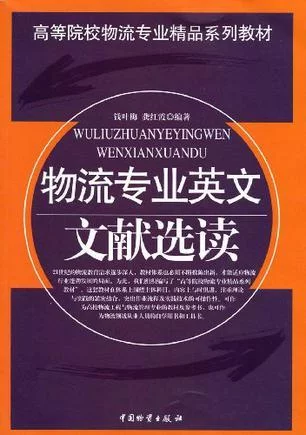物流专业英文文献选读

《物流专业英文文献选读》是2009年5月1日中国物资出版社出版的图书,作者是钱叶梅、龚红霞。
- 书名 物流专业英文文献选读
- 作者 钱叶梅、龚红霞
- 出版社 中国物资出版社
- 出版时间 2009年5月1日
- 页数 352 页
内容简介
《物流专业英文文献选读》内容为:21世纪的物流教育需求逐步深入,教材体系也必须不断推陈出新,才能适应物流行业蓬勃发展的书面。为此,我们组织编写了"高等院校物流专业精品系列教材"。这套教材在体系上围绕主体科目,内容上与时俱进,注重理论与实践的紧密结合,突出作业流程及实践技术的可操作性。可作为高校物流工程与物流管理专业的教材及参考书,也可作为物流领域从业人士的的学用书和工具书。
目录
Chapter 1 An Introduction to Logistics
1. 1 Basic knowledge preparing
1.1.1 History
1.1.2 What is logistics
1.1.3 Evolution of the logistics management concept
1.2 Logistics system
1. 2. 1 Elements of logistics
1.2. 2 Activities of logistics system
1.3 The new logistics management paradigm
1.3.1 The internet B2B economy
1.3.2 Reverse logistics
1.3.3 Real-time logistics event management
1.3.4 Technology solutions provide visibility
Words and terms
Notes
Exercises
After-class reading
Chapter 2 Customer Service
2. 1 Surroundings introduction
2. 1.1 The marketing perspective
2. 1.2 Quality of service
2. 1.3 Case study
2. 1.4 Customer loyalty
2. 2 Basic knowledge preparing
2. 2. 1 The role of customer service
2.2. 2 Concept of customer service
2. 2. 3 The components of customer service
2.2.4 Customer service policy
2.3 Service level
2. 3.1 Defining customer service objectives
2. 3.2 Service level and cost
2. 3.3 Setting service standards
2.3.4 Measuring customer service
Words and terms
Notes
Exercises
After-class Reading
Chapter 3 Warehouse Management
3.1 Basic knowledge preparing
3.1.1 The role of warehouses
3.1.2 Types of warehouse or distribution
3.1.3 Warehouse operations
3. 1.4 The functionality of warehouse
3.2 Warehouse management
3.2. 1 Warehouse costs
3.2. 2 Warehouse decision
3.2.3 Objective and principles of good warehouse design and management
3.2. g Strategic issues affecting warehousing
3.2. 5 Modem warehouse
Words and terms
Notes
Exercises
After-class reading
Chapter 4 Inventory
4. 1 Basic knowledge preparing
4. 1. 1 Role of inventory and functionality
4. 1.2 Types of stock-holding
4. 1.3 Inventory costs
4. 1.4 Inventory goals
4. 2 Inventory replenishment systems
4. 2. 1 Reorder quantities
4. 2. 2 Demand forecasting
4. 3 Inventory management
4. 3. 1 Problems with traditional approaches to inventory planning
4. 3.2 Different inventory requirements
4. 3.3 The lead-time gap
4. 3.4 The problems of high levels of inventory and the approache:
4. 3.5 Analyzing time and inventory
Words and terms
Notes
Exercises
After-class reading
Chapter 5 Transportation
5.1 Basic knowledge preparing
5.1.1 Definition
5.1.2 Importance of an effective transportation
5.1.3 The single-service choices
5. 1.4 Intermodal services
5.1.5 Transportation characteristics
5.2 Transportation management
5.2. 1 Creating economic utility
5.2. 2 Transport cost characteristics
5.2. 3 Service choices and their characteristics
5.2.4 The economic factors of transportation
5.2. 5 Transportation documentation
5.2.6 Market and pricing decisions
Words and terms
Notes
Exercises
After-class reading
Chapter 6 Logistics Information
6. 1 Logistics information system
6. 1.1 Logistics information system overview
6. 1.2 Information functionality
6. 1.3 The importance of information in logistics management
6. 2 Information technology
6. 2. 1 Introduction to the information technology
6. 2. 2 Use of EDI in the supply chain
6. 2. 3 Technology at UPS
6.3 Logistics information management
6.3.1 Principles of logistics information
6.3.2 DANZAS' principles of logistics information
Words and terms
Notes
Exercises
After-class reading
Chapter 7 Supply Chain Management
7. 1 Basic knowledge preparing
7. 1.1 Concepts of supply chains and its management
7. 1.2 Model of supply chain management
7. 1.3 Key attributes of supply chain management
7. 1.4 Seven principles of supply chain
7. 1.5 Agile supply chain and its principles
7.2 Supply chain management and demand chain management
7.2. 1 Supply chain management
7.2. 2 Demand chain management
7.2. 3 Demand/supply chain linkages
Words and terms
Notes
Exercises
After-class reading
Chapter 8 Logistical Strategy
8. 1 Basic knowledge preparing
8. 1.1 Why formulate logistics strategies
8. 1.2 A conceptual approach to formulating logistics strategy
……
Chapter 9 Outsourcing Logistics
Chapter 10 International Logistic
Chapter 11 Global Logistics
Chapter 12 Performance Measurement in Supply Chain
Chapter 13 New Diections in Logistics